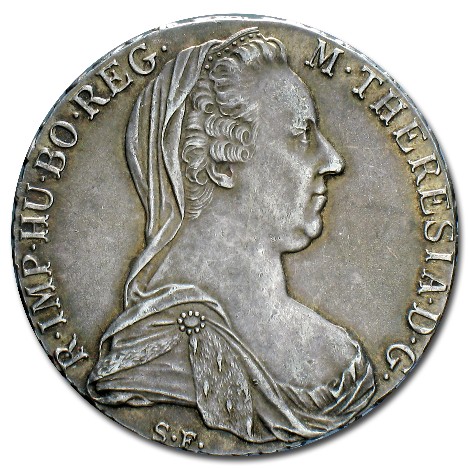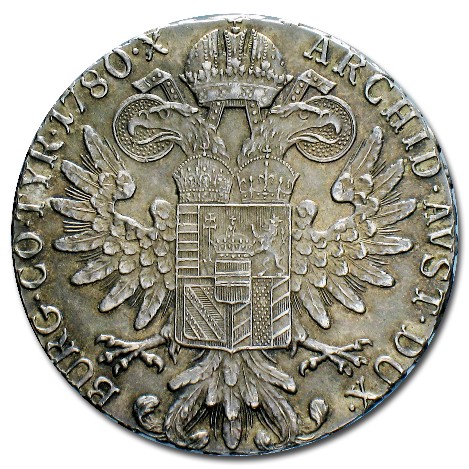Der Thaler - Moruzzi Numismatica - Münzen Medaillen und Banknoten
Hauptmenü:
- Einführung in die Numismatik und in Sammlungen
- Die Abkürzungen der Münzen
- Antike Münzsammlungen in Italien
- Der Erhaltungszustand der Münzen
- Rarität
- Numismatisches Literaturverzeichnis
- Fälschungen
- Subaerate Münzen
- Die römische Frau in den Bildern der Augusten
- Römische Tesserae mit Ziffern und Spintriae
- Der Ara Pacis
- Der Tempel des Jupiters
- Domitianus
- Der Solidus von Jovinus
- Internationale Münzen
Der Thaler


The Thaler was born in Germany as the rising middle class needed to have coins more suitable in weight without using gold coins in trade - often foreign, too heavy and inconvenient, above all when people worked with large sums - or the pre-existent silver coins - following the model of the king Louis IX of France - with a too reduced intrinsic value. In reality a first step towards the Thaler was made in 1486 when the Archduke Sigismund of Tyrol, realizing the great shortage of its gold reserves, established that the ratio between gold and silver were of 1/12 and so he began to mint silver coins of large diameter: the Guildiners or silver florins. The discovery of large silver deposits in many areas of the Empire facilitated everywhere the spread and the imitation of the new coins, from Rhineland to Hungary. In 1520 the Count Steffan Schlick of Bassano del Grappa, taking advantage of the authorization to coin money obtained by the Diet of Bohemia in 1517, coined at Joachimsthal mint a Guldiner with the image of St. Joachim: at the beginning, this coin was called Joachimsthaler, then the name was abbreviated to Thaler until it acquired the present form of Taler. The Thaler spread in an exceptional way. The need of markets and even the vanity of the German rulers, admiring their beautiful heraldic insignia, gave impetus to mint Thaler multiples, which over the time became coins of ostentation or "magic" and "supernatural" coins. The intrinsic silver value remained stable for nearly two centuries when the money circulated and, thanks to this prestige and continuity, it soon overcame the boundaries of the Habsburg Empire. The success of the coin in these territories was due also to the elegant appearance of the coin. Through Balkans, it entered completely into the Ottoman Empire and from Middle East it was introduced in Africa. In Africa it circulated from Sudan to Angola and Mozambique, proceeding to the Atlantic and to the archipelago of the Azores. With the opening of the Suez Canal (1869), the axis of trade passed from the Atlantic to the Indian Ocean and the coin reached the Horn of Africa, Tanganyika and Zanzibar. It also circulated in the Far East, through the ports of Macao and the Java and Indonesian islands (the Dutch Indies). The success of the Empress Thaler was also promoted by Venice, who entertained trade throughout the Levant, spreading more and more its use. Italy also did not remain immune to this circulation, as it even coined and imitated the Austrian exemplars. Florence was the first to do it, as the Grand Duke Ferdinand III of Lorraine, between 1814 and 1818, coined Thalers with a diameter slightly inferior to the original type. The mint of Milan between 1820 and 1846 coined numerous quantities of Maria Theresa thalers. Even Genoa coined Empress Thalers, but Venice minted them even more. However, the most abundant coinage of Maria Theresa Thalers on Italian soil took place in Rome. The Italian Government already ordered in 1918 the realization of a Thaler for the colony of Eritrea, imitating the Maria Theresa one, but it was a big failure, because the bust of "Italy" on the obverse had not an important sign of recognition for natives: the brooch supporting the mantle of Maria Theresa, index of the coin consumption state. On the obverse of the Thaler there is the Empress bust in mature age and with the widowed veil, while on the reverse there is the double eagle crowned with the shield of the Habsburg Empire (quadripartite shield with arms of Hungary, Bohemia, Burgundy, Burgau).
Jede Äußerung eines Individuums ist verschieden und basiert auf einer eigenen Sichtweise. Ein Großteil von intellektuellem Eigentum wird besonders im Internet zur freien Verfügung Aller gestellt. Dabei dürfen jedoch weder die moralischen noch die rechtlichen Pflichten außer Acht gelassen werden, die vorsehen, das Werk des Urhebers zu schützen und dieses nicht ohne Übereinstimmung des Verfassers zu übernehmen. Copyright Moruzzi Numismatica © 1999-2016